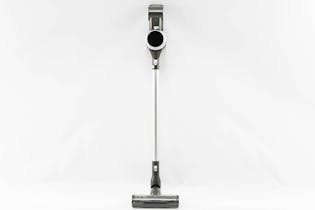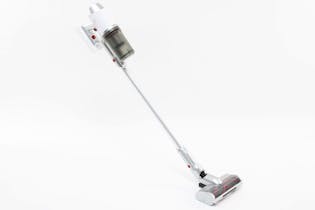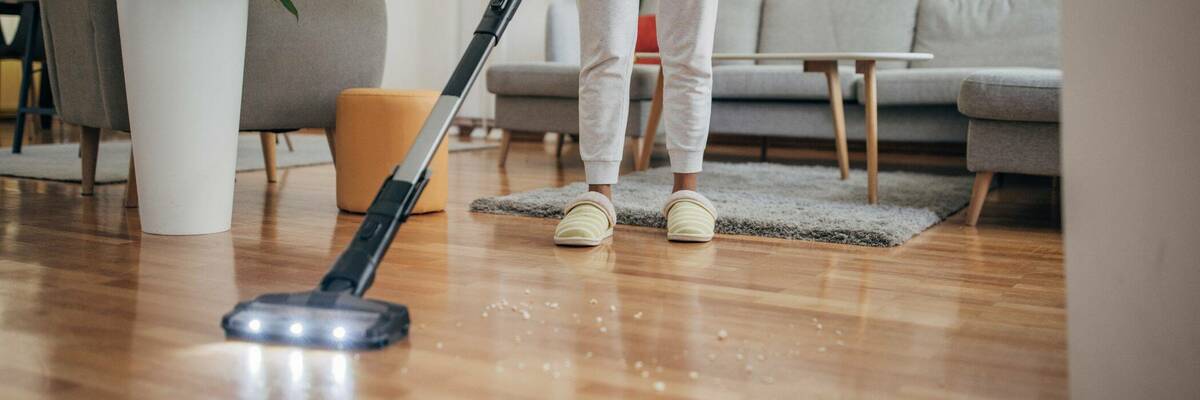Stick vacuum cleaners
Find the best cordless stick vacuum for your home with our buying guide and test results of 15 brands including Dyson, Miele and Kmart’s Anko.
Stick vacuums are light, portable and ideal for quick cleaning jobs. The performance of these cordless vacuums now rivals that of corded vacs. But which model is right for you? Our stick vacuum buying guide can help you choose.
Stick vacuum pros and cons
There’s little separating stick vacuums from their corded counterparts – there was almost no difference in how they performed in our tests for cleaning carpet and picking up pet hair. But that doesn't mean a cordless vacuum is the right choice for every home.

- Easier to use in tight spaces.
- Smaller and less difficult to store.
- Easier to manoeuvre, especially on stairs.
- Some allow the wand to be detached – ideal for cleaning the car.
- Smaller dustbins mean more frequent emptying.
- Long charge times (average five hours).
- Minimal to no on-board storage for attachments.
- Can struggle to clean larger homes in one go.

Looking for a standard vacuum?
Check out our buying advice and test results for standard corded vacuums.
What to consider when buying a cordless stick vacuum
Here’s some features you should consider, to know which stick vacuum is the perfect choice for your home.
Weight and balance
Some stick vacuums have the motor down by the head, which generates better suction power, while others have the motor up by the handle, allowing better manoeuvrability. This means the weight and centre of gravity for each model is different. If you’re unsure configuration of stick vac would suit you, we recommend visiting a shop and trying out a few different models.
Charging/runtime
Stick vacuum battery life is the biggest downside of this type of vacuum – they run for just an average of 15 minutes and take about 5 hours to charge. One way to get the most out of your cordless stick vacuum is buying a model that has a swappable battery and getting a spare battery.
Corded vs cordless
Here are some corded stick vacuums on the market that connect to mains power like a standard vacuum. For these models it’s important to note how long the power cable is, as this can limit your vacuuming range and how easy the stick vac is to store away.
Variable power
Most stick vacuums come with two or three power settings. If you regularly clean your home, you don’t need to always run your cordless vac at maximum power. Using lower speeds extends battery life and helps reduce noise.
Accessories/heads
Many stick vacs have interchangeable heads for different jobs, such as a head with brushes for carpet or soft roller heads for hard floors. However, a cordless vac’s compact size means there often isn’t space to store the heads on the machine, so some models come with a charging dock that can store attachments.
Common attachments for stick vacs include a rolling brush head (powered and not), crevice tool, dusting brush and soft roller head for hardwood floors.
Handheld mode
Many (but not all) stick vacs can convert into a handheld vacuum for awkward cleaning jobs, such as cleaning the car.
Filters
High-efficiency particulate air (HEPA) filters, also known in Europe as an S-class, are designed to filter out very small invisible particles while you vacuum. (To be technical, they trap 99.97% of particle emissions down to 0.3 microns in size – that’s small enough to remove cigarette smoke and bacteria.) If you have asthma or breathing difficulties, strongly consider a stick vacuum with a HEPA filter. HEPA filters become less efficient as they clog with dust, so need to be replaced each year.
Noise
If your cordless stick vac has variable power, a lower power setting will likely be quieter, though you might need a few extra passes to make up for the weaker suction.
Usability
Items to check are the stick vacuum’s reach (from your hand to the end of the cleaning head), weight, comfort of carrying and ease of emptying the bin. Check the on/off switch or trigger is easy to operate, and that it’s easy to manoeuvre and, if applicable, switch the heads.
Dustbin
Designs vary between manufacturers, so make sure you can easily remove and empty the bin on the stick vac before buying. Emptying the bin after every use also ensures it’s ready to go next time you need the vacuum cleaner.
Battery
Lithium-ion (Li-ion) are the most common type of batteries used in stick vacs. Many models have swappable batteries, meaning you can switch out a dead battery for a fresh spare in just a few minutes.
Affordability
The popularity of stick vacuum brands such as Dyson, Samsung and Miele often comes with a hefty price tag. But there are some more inexpensive models that perform well and won’t hurt your wallet. The cheapest stick vacuums are still something to be wary of, though; to get a good affordable model you should look to spend at least $500.
Three things to keep in mind when buying a stick vacuum
A stick vacuum with a built-in battery will have a limited life. The battery in these units can’t be replaced easily, so when the battery dies it’s often cheaper and more practical to buy a new vacuum than repair it.
Replacing a broken head for a stick vacuum cleaner isn’t always easy. Some cordless vacuums have a single head attached to the main body, for example the Electrolux Ergorapido. In this case, it can be easier and cheaper to replace the whole vacuum than repair it.
It’s a common assumption that all stick vacs can convert into a handheld unit for cleaning small, awkward spaces areas, such as the car, but this isn’t the case. If this is important to you, check the model you’re buying has this feature.
Our expert's advice for keeping your stick vac in top condition
Clean the filter – we recommend cleaning your stick vacuum’s filters once a month. Before buying, check where and how many filters the vacuum has, and if they are easy to remove and clean.
Sore trigger finger – if your cordless stick vac has an on/off trigger, like Dyson models, only hold it down when you’re vacuuming and release it when moving between areas.
Tangled hair – known as the Rapunzel effect, long hair can get tangled in the vacuum head and be hard to remove. On most stick vac power brush heads, there is a gap in the bristles around the head. You can run a pair of scissors or a safety box cutter, along this gap, cutting the hair so it’s easy to pull off.
See our easiest way to remove hair from your vacuum cleaner brush article for advice on how to do this.
Ready to buy a new stick vacuum?
See our stick vacuum review to compare the cleaning performance of stick vacuums from over 15 brands, including Dyson, Miele, Hoover and LG.

Tell us about your broken vac
Whether the fault is catastrophic or just annoying, we need your help. Take our two-minute survey to report what went wrong.
Buying a secondhand stick vacuum
A new stick vacuum can be a costly purchase, if you want to get the best model, and buying secondhand can be a great way to keep costs down. However, you should do your research and perform some pre-purchase checks before you part with your hard-earned cash.
There are new stick vacuum models released every year and that means older models may no longer feature in our current test results. To get around this, we’ve recently added discontinued models to our test results. You can check how well many older stick vacuum models perform on our compare page – just choose ’Discontinued’ in the ‘Availability’ drop-down menu in the filters.

How old should a secondhand stick vacuum be?
Cordless stick vacuums unfortunately have a shorter lifespan than standard vacuums, mainly because of their batteries, so you want to buy one that’s relatively ‘young’. When buying secondhand, look for one that’s less than 3 years old – a stick vacuum battery may fail or drop capacity to the point where it's no longer useful within the first 5 years of ownership.
Stick vacuum batteries
The big downside of stick vacuums is the battery. Battery capacity decreases over time, so buying secondhand means you won’t get a cordless vacuum with a full capacity battery.
If the battery is a built-in, non-removable one, then the stick vacuum will only last as long as the battery does, which can be hard to judge. But if you can replace the battery, you can generally expect a few more good years from a cordless vacuum before it goes kaput.
A replaceable battery is one you can usually replace yourself without taking it to an electrician. It should only take a few screws to remove the battery and fit a new one. There should also be clear instructions in the manual on how to replace it.
A swappable batteryis one that easily unclips from the vacuum, with no tools necessary. Ideally, models with a swappable battery will come with a spare battery or offer one easily available for purchase.
If the battery isn’t easily replaceable or swappable, then we recommend you don’t buy the vacuum. See our How easy is it to repair a Kmart stick vacuum article for more on this.
Pre-purchase stick vac checks
Is the battery replaceable or swappable? If not, then don’t buy.
Check if spare/replacement batteries are available for purchase and how much they cost.
Is the stick vac clean? Does it look like it’s been looked after?
Check the condition of any filters. Are they washable or are spares available?
Check the charger for any damage.
Check all the clips from the head to the wand. Do all attachments connect?
Test any mechanisms on the floor head, and whether the wheels run freely.
Turn it on! Place the palm of your hand on the end of the hose – it should suction on with some force.
Download the manual – if it didn’t come with a physical manual, check the manufacturer’s website for a digital one.
Your rights if things go wrong
Bought something and want to take it back? Here's what you need to know about your rights. Consumer members can contact our Consumer Advice Line for help. Our advisers will talk you through your rights.
Buying new
If a product you buy is faulty or not of acceptable quality, you don’t have to put up with it. The Consumer Guarantees Act has got you covered – you don’t need a warranty. Here's more about how you can get a refund, repair or replacement for a faulty product.
Buying used
What are your consumer rights when purchasing a second-hand stick vacuum cleaner? It depends on the seller. If you’re buying from a second-hand dealer (including those listed as ‘In-trade on Trade Me) and discover the item’s faulty, you're covered by the Consumer Guarantees Act. The product you buy should be of acceptable quality, fit for purpose and match the description. However, if you’re dealing with a private seller, you’re not covered by the act. Here's more info about your rights when buying second-hand goods.
We've tested 119 stick vacuum cleaners.
Find the right one for you.
Akitas
.jpg&w=315&q=75)
Anko

Anko



